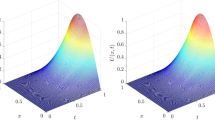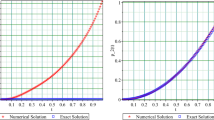Abstract
In this paper, we propose a time discontinuous Galerkin scheme for solving the nonlinear time-fractional Schrödinger equation using B-splines in time and Non-Uniform Rational B-splines in space. The technique of comparing real and imaginary parts is utilized to obtain optimal \(L^2([0,T];L^2(\varOmega ))\) norm error estimate. Specifically, we have achieved \(r+1\) accuracy in time and \(p+1\) accuracy in space, where r and p represent the spline degrees in time and space, respectively. The convergence analysis is also provided on time graded mesh, taking into account solutions with initial singularity. Additionally, the space–time isogeometric analysis method is employed to solve the linear time-fractional Schrödinger equation. A new discrete norm is constructed, and the well-posedness analysis and error estimate are performed based on this norm. We can attain \(\hat{p}\) accuracy concerning the new discrete norm error in space–time domain, where \(\hat{p}\) denotes space–time spline degree. Theoretical results are validated through using numerical examples.







Similar content being viewed by others
Data Availability
Enquiries about data availability should be directed to the authors.
References
Adams, R.A., Fournier, J.J.: Sobolev Spaces. Elsevier, Amsterdam (2003)
Antoine, X., Arnold, A., Besse, C., Ehrhardt, M., Schädle, A.: A review of transparent and artificial boundary conditions techniques for linear and nonlinear Schrödinger equations. Commun. Comput. Phys. 4(4), 729–796 (2008)
Aziz, A.K., Monk, P.: Continuous finite elements in space and time for the heat equation. Math. Comput. 52(186), 255–274 (1989)
Bazilevs, Y., da Veiga, L.B., Cottrell, J.A., Hughes, T.J.R., Sangalli, G.: Isogeometric analysis: approximation, stability and error estimates for \(h\)-refined meshes. Math. Models Methods Appl. Sci. 16(7), 1031–1090 (2006)
Cao, W., Zhang, Z., Karniadakis, G.E.: Time-splitting schemes for fractional differential equations I: smooth solutions. SIAM J. Sci. Comput. 37(4), A1752–A1776 (2015)
Chen, L., Lü, S.: Spectral approximation for nonlinear time fractional Schrödinger equation on graded meshes. Int. J. Comput. Math. 99(12), 2524–2541 (2022)
Chen, X., Di, Y., Duan, J., Li, D.: Linearized compact ADI schemes for nonlinear time-fractional Schrödinger equations. Appl. Math. Lett. 84, 160–167 (2018)
Chen, Y., Wang, L., Yi, L.: Exponential convergence of \(hp\)-discontinuous Galerkin method for nonlinear Caputo fractional differential equations. J. Sci. Comput. 92(3), 99 (2022)
De Falco, C., Reali, A., Vázquez, R.: GeoPDEs: a research tool for isogeometric analysis of PDEs. Adv. Eng. Softw. 42(12), 1020–1034 (2011)
Dedè, L., Quarteroni, A.: Isogeometric analysis for second order partial differential equations on surfaces. Comput. Methods Appl. Mech. Eng. 284, 807–834 (2015)
Duan, B., Jin, B., Lazarov, R., Pasciak, J., Zhou, Z.: Space–time Petrov–Galerkin FEM for fractional diffusion problems. Comput. Methods Appl. Math. 18(1), 1–20 (2018)
Gander, M.J.: 50 years of time parallel time integration. In: Multiple Shooting and Time Domain Decomposition Methods. Contributions in Mathematical and Computational Sciences, vol. 9, pp. 69–113. Springer, Cham (2015)
Glassey, R.T.: On the blowing up of solutions to the Cauchy problem for nonlinear Schrödinger equations. J. Math. Phys. 18(9), 1794–1797 (1977)
Gómez, H., Calo, V.M., Bazilevs, Y., Hughes, T.J.R.: Isogeometric analysis of the Cahn–Hilliard phase-field model. Comput. Methods Appl. Mech. Engrg. 197(49–50), 4333–4352 (2008)
Heid, P., Wihler, T.P.: Adaptive iterative linearization Galerkin methods for nonlinear problems. Math. Comput. 89(326), 2707–2734 (2020)
Heid, P., Wihler, T.P.: On the convergence of adaptive iterative linearized Galerkin methods. Calcolo 57(3), 24 (2020)
Hu, X., Zhu, S.: Isogeometric analysis for time-fractional partial differential equations. Numer. Algorithms 85(3), 909–930 (2020)
Huang, C., Stynes, M.: Optimal \(H^1\) spatial convergence of a fully discrete finite element method for the time-fractional Allen–Cahn equation. Adv. Comput. Math. 46(4), 63 (2020)
Hughes, T.J.R., Cottrell, J.A., Bazilevs, Y.: Isogeometric analysis: CAD, finite elements, NURBS, exact geometry and mesh refinement. Comput. Methods Appl. Mech. Eng. 194(39–41), 4135–4195 (2005)
Iomin, A.: Fractional-time Schrödinger equation: fractional dynamics on a comb. Chaos Solit. Fractals 44(4–5), 348–352 (2011)
Jin, B., Li, B., Zhou, Z.: Numerical analysis of nonlinear subdiffusion equations. SIAM J. Numer. Anal. 56(1), 1–23 (2018)
Karakashian, O., Makridakis, C.: A space-time finite element method for the nonlinear Schrödinger equation: the discontinuous Galerkin method. Math. Comput. 67(222), 479–499 (1998)
Keraani, S.: On the blow up phenomenon of the critical nonlinear Schrödinger equation. J. Funct. Anal. 235(1), 171–192 (2006)
Khan, N.A., Hameed, T.: An implementation of Haar wavelet based method for numerical treatment of time-fractional Schrödinger and coupled Schrödinger systems. IEEE/CAA J. Autom. Sin. 6(1), 177–187 (2019)
Langer, U., Steinbach, O.: Space–Time Methods: Applications to Partial Differential Equations, vol. 25. Walter de Gruyter GmbH & Co KG (2019)
Langer, U., Schafelner, A.: Adaptive space–time finite element methods for non-autonomous parabolic problems with distributional sources. Comput. Methods Appl. Math. 20(4), 677–693 (2020)
Langer, U., Schafelner, A.: Adaptive space–time finite element methods for parabolic optimal control problems. J. Numer. Math. 30(4), 247–266 (2022)
Langer, U., Moore, S.E., Neumüller, M.: Space–time isogeometric analysis of parabolic evolution problems. Comput. Methods Appl. Mech. Eng. 306, 342–363 (2016)
Larsson, S., Thomée, V., Wahlbin, L.B.: Numerical solution of parabolic integro-differential equations by the discontinuous Galerkin method. Math. Comput. 67(221), 45–71 (1998)
Lasaint, P., Raviart, P.A.: On a finite element method for solving the neutron transport equation. In: Mathematical Aspects of Finite Elements in Partial Differential Equations, pp. 89–123. Mathematics Research Center, University of Wisconsin-Madison, Academic Press, New York (1974)
Li, D., Wang, J., Zhang, J.: Unconditionally convergent \(L1\)-Galerkin FEMs for nonlinear time-fractional Schrödinger equations. SIAM J. Sci. Comput. 39(6), A3067–A3088 (2017)
Li, D., Zhang, J., Zhang, Z.: The numerical computation of the time fractional Schrödinger equation on an unbounded domain. Comput. Methods Appl. Math. 18(1), 77–94 (2018)
Li, R., Wu, Q., Zhu, S.: Proper orthogonal decomposition with SUPG-stabilized isogeometric analysis for reduced order modelling of unsteady convection-dominated convection–diffusion–reaction problems. J. Comput. Phys. 387, 280–302 (2019)
Li, R., Wu, Q., Zhu, S.: Isogeometric analysis with proper orthogonal decomposition for elastodynamics. Commun. Comput. Phys. 30(2), 396–422 (2021)
Liu, J., Wang, T., Zhang, T.: A second-order finite difference scheme for the multi-dimensional nonlinear time-fractional Schrödinger equation. Numer. Algorithms 92(2), 1153–1182 (2023)
McLean, W., Mustapha, K.: A second-order accurate numerical method for a fractional wave equation. Numer. Math. 105(3), 481–510 (2007)
McLean, W., Thomée, V., Wahlbin, L.B.: Discretization with variable time steps of an evolution equation with a positive-type memory term. J. Comput. Appl. Math. 69(1), 49–69 (1996)
Merle, F., Raphael, P.: The blow-up dynamic and upper bound on the blow-up rate for critical nonlinear Schrödinger equation. Ann. Math. (2) 161(1), 157–222 (2005)
Moore, S.E.: Space-time multipatch discontinuous Galerkin isogeometric analysis for parabolic evolution problems. SIAM J. Numer. Anal. 57(3), 1471–1493 (2019)
Mustapha, K.: A superconvergent discontinuous Galerkin method for Volterra integro-differential equations, smooth and non-smooth kernels. Math. Comput. 82(284), 1987–2005 (2013)
Mustapha, K.: Time-stepping discontinuous Galerkin methods for fractional diffusion problems. Numer. Math. 130(3), 497–516 (2015)
Mustapha, K., Schötzau, D.: Well-posedness of \(hp\)-version discontinuous Galerkin methods for fractional diffusion wave equations. IMA J. Numer. Anal. 34(4), 1426–1446 (2014)
Mustapha, K., Brunner, H., Mustapha, H., Schötzau, D.: An \(hp\)-version discontinuous Galerkin method for integro-differential equations of parabolic type. SIAM J. Numer. Anal. 49(4), 1369–1396 (2011)
Mustapha, K., Abdallah, B., Furati, K.M., Nour, M.: A discontinuous Galerkin method for time fractional diffusion equations with variable coefficients. Numer. Algorithms 73(2), 517–534 (2016)
Naber, M.: Time fractional Schrödinger equation. J. Math. Phys. 45(8), 3339–3352 (2004)
Peng, L., Zhou, Y., Ahmad, B.: The well-posedness for fractional nonlinear Schrödinger equations. Comput. Math. Appl. 77(7), 1998–2005 (2019)
Piegl, L., Tiller, W.: The NURBS Book. Springer Science & Business Media, Berlin (1996)
Saadé, C., Lejeunes, S., Eyheramendy, D., Saad, R.: Space-time isogeometric analysis for linear and non-linear elastodynamics. Comput. Struct. 254, 106594 (2021)
Schwab, C.: \(p\)- and \(hp\)-Finite Element Methods. Oxford University Press, New York (1998)
Sun, Z.Z.: The stability and convergence of an explicit difference scheme for the Schrödinger equation on an infinite domain by using artificial boundary conditions. J. Comput. Phys. 219(2), 879–898 (2006)
Sun, Z.Z., Zhang, J., Zhang, Z.: Optimal error estimates in numerical solution of time fractional Schrödinger equations on unbounded domains. East Asian J. Appl. Math. 8(4), 634–655 (2018)
Tagliabue, A., Dedè, L., Quarteroni, A.: Isogeometric analysis and error estimates for high order partial differential equations in fluid dynamics. Comput. Fluids 102, 277–303 (2014)
Thomée, V.: Galerkin Finite Element Methods for Parabolic Problems, vol. 25. Springer Science & Business Media, Berlin (2007)
Tofighi, A.: Probability structure of time fractional schrödinger equation. Acta Phys. Polo. A. 116(2), 114–118 (2009)
Valizadeh, N., Rabczuk, T.: Isogeometric analysis for phase-field models of geometric PDEs and high-order PDEs on stationary and evolving surfaces. Comput. Methods Appl. Mech. Engrg. 351, 599–642 (2019)
Vázquez, R.: A new design for the implementation of isogeometric analysis in Octave and Matlab: GeoPDEs 3.0. Comput. Math. Appl. 72(3), 523–554 (2016)
Wang, L., Tian, H., Yi, L.: An \(hp\)-version of the discontinuous Galerkin time-stepping method for Volterra integral equations with weakly singular kernels. Appl. Numer. Math. 161, 218–232 (2021)
Wang, Y., Wang, G., Bu, L., Mei, L.: Two second-order and linear numerical schemes for the multi-dimensional nonlinear time-fractional Schrödinger equation. Numer. Algorithms 88(1), 419–451 (2021)
Yang, Y., Wang, J., Zhang, S., Tohidi, E.: Convergence analysis of space-time Jacobi spectral collocation method for solving time-fractional Schrödinger equations. Appl. Math. Comput. 387, 124489 (2020)
Yuan, W., Li, D., Zhang, C.: Linearized transformed \(L1\) Galerkin FEMs with unconditional convergence for nonlinear time fractional Schrödinger equations. Numer. Math. Theory Methods Appl. 16(2), 348–369 (2023)
Yuan, W., Zhang, C., Li, D.: Linearized fast time-stepping schemes for time-space fractional Schrödinger equations. Physica D 454, 133865 (2023)
Zhang, J., Li, D., Antoine, X.: Efficient numerical computation of time-fractional nonlinear Schrödinger equations in unbounded domain. Commun. Comput. Phys. 25(1), 218–243 (2019)
Zhang, M., Mao, X., Yi, L.: Exponential convergence of the \(hp\)-version of the composite Gauss–Legendre quadrature for integrals with endpoint singularities. Appl. Numer. Math. 170, 340–352 (2021)
Zheng, Y., Zhao, Z.: The time discontinuous space-time finite element method for fractional diffusion-wave equation. Appl. Numer. Math. 150, 105–116 (2020)
Zhu, S., Dedè, L., Quarteroni, A.: Isogeometric analysis and proper orthogonal decomposition for parabolic problems. Numer. Math. 135(2), 333–370 (2017)
Acknowledgements
The second author was supported in part by the National Natural Science Foundation of China through grant [12101509] and the third author was supported in part by the Science and Technology Development Fund, Macau SAR (File No. 0151/2022/A) and University of Macau (File Nos. MYRG2020-00035-FST, MYRG2022-00076-FST). The authors sincerely appreciate Professor Zhizhong Sun for his insightful suggestions and discussions. The authors thanks the anonymous referees for their constructive comments and suggestions which have improved the quality of this paper.
Author information
Authors and Affiliations
Corresponding author
Ethics declarations
Conflict of interest
The authors declare that they have no conflict of interest.
Additional information
Publisher's Note
Springer Nature remains neutral with regard to jurisdictional claims in published maps and institutional affiliations.
Appendix
Appendix
1.1 Auxiliary Lemmas
In this part, we will introduce several useful Lemmas about fractional operator \({_{a}}I_t^{\alpha }\).
Lemma 7
[57, Lemma 2.1] If \(\alpha < 1\) and \(q\in L^2(I_n)\), then
Specially, if \(q\in L^2([0,t_n])\), we have
Lemma 8
[42, Lemma 3.1] Let real functions \(q,w\in L^2([a,b])\), then we have
-
(i)
\(\int _{a}^{b}q(t)\left( {_{a}}I_t^{\alpha } q\right) dt=\frac{1}{K}\Vert {_{a}}I_t^{\frac{\alpha }{2}} \tilde{q}\Vert ^2_{L^2([0,\infty ))}\);
-
(ii)
\(\left[ \int _{a}^{b}q(t)\left( {_{a}}I_t^{\alpha } w\right) dt\right] ^2\le K^2\left[ \int _{a}^{b}q(t)\left( {_{a}}I_t^{\alpha }q\right) dt\right] \left[ \int _{a}^{b}w(t)\left( {_{a}}I_t^{\alpha } w\right) dt\right] \),
where \(K=1/\cos (\alpha \pi /2)\) and \(\tilde{q}\) are the extension of q outside of [a, b] by zero.
Lemma 9
If \(u\in L^2(I_n)\) is a complex function, it holds that
Proof
We assume that \(u=u_1+iu_2\), where \(u_1\) and \(u_2\) are real functions. Using the positive semi-definite property of the fractional integral \({_{a}}I_t^{\alpha }\) [36, 37], we can derive the following result:
Besides, according to Lemma 8 and Cauchy inequality, one can get
Then using triangle inequality and (45), we have
The proof is completed. \(\square \)
The following result ensures the rationality of discrete norm defined in space–time IGA method.
Lemma 10
For complex functions \(u,v\in L^2([0,T])\), we have
Proof
Let us first consider the case where u and v are real functions. Using Lemma 8, one has
where \(\tilde{u}\) and \(\tilde{v}\) are the extension of u and v outside of [0, T] by zero, respectively.
Next, let us consider the case where u and v are complex functions, and set \(u=u_1+iu_2\) and \(v=v_1+iv_2\), where \(u_1\), \(u_2\), \(v_1\) and \(v_2\) are real functions. Making use of the result (46) for real functions, we have
where the last inequality is obtained by using the result \(\sqrt{(a+b)^2+(c+d)^2}\le \sqrt{a^2+c^2}+\sqrt{b^2+d^2}.\)
This proof is completed. \(\square \)
The following is a fractional Grönwall inequality.
Lemma 11
[29, Lemma 6.4] Let \(\left\{ a_n\right\} _{n=1}^{N}\) and \(\left\{ b_n\right\} _{n=1}^{N}\) be nonnegative sequences and \(\left\{ b_n\right\} _{n=1}^{N}\) is monotonically increasing. Assume that
where \(c\geqslant 0\) and \(\omega _{n,j}(\alpha )=\int _{I_j}(t_n-t)^{\alpha -1}dt\). When \(0< \alpha \le 1\) and \(\delta =\frac{c \tau ^{\alpha }}{\alpha }<1\), it holds that
where C is a constant related to \(\delta \), \(\alpha \), c and T.
1.2 Implementation of Space–Time Methods
Here we present algorithms for solving problems (8) and (32). For the former, our approach involves integrating first in time direction and deriving a nonlinear system of equations about spatial degrees of freedom on every time slice. We then use an Picard iteration to solve this nonlinear system, which is feasible due to the conclusion of Theorem 2. Specifically, we set the iteration termination error to be \(10^{-12}\). For the latter, we solve a sparse linear system of equations using LU decomposition technology.
Firstly, we assume that \(\left\{ B^n_{j,r_n}(t)\right\} _{j=1}^{r_n+1}\), \(\left\{ S_j(\textbf{x})\right\} _{j=1}^{K}\), \(\left\{ N_j(\textbf{x},t)\right\} _{j=1}^{W}\) form a set of basis for spaces \(\mathcal {B}^{r_n}(I_n)\), \(\mathcal {V}_{0h}(\varOmega )\) and \(\mathcal {V}_{0h}(Q)\), respectively. Then the approximation for the solution of NTFS or LTFS takes the form:
where \(P_{j,n}(\textbf{x})=\sum _{k=1}^{K}c^{n}_{jk}S_k(\textbf{x})\).
Furthermore, for the sake of convenience, we define
Next, we will give the main steps to solve (8).
Solve problem (8).
When considering (32), formalism can be easily implemented as we only need to solve
where \(A=\left( a_{jk}\right) _{W,W}\) with \(a_{jk}=a_h(N_k,N_j)\), \(\textbf{c}=\left( c_1,c_2,\ldots ,c_W\right) ^T\) and \(\textbf{f}=(f_{j})_{W,1}\) with \(f_{j}=l_h(N_j)\). For larger matrices A, we can also consider using some precondition techniques or iterative methods in parallel.
Rights and permissions
Springer Nature or its licensor (e.g. a society or other partner) holds exclusive rights to this article under a publishing agreement with the author(s) or other rightsholder(s); author self-archiving of the accepted manuscript version of this article is solely governed by the terms of such publishing agreement and applicable law.
About this article
Cite this article
Ge, A., Shen, J. & Vong, S. Space–Time Methods Based on Isogeometric Analysis for Time-fractional Schrödinger Equation. J Sci Comput 97, 76 (2023). https://doi.org/10.1007/s10915-023-02398-w
Received:
Revised:
Accepted:
Published:
DOI: https://doi.org/10.1007/s10915-023-02398-w
Keywords
- Time-fractional Schrödinger equation
- Time discontinuous Galerkin
- Space–time isogeometric analysis
- Graded mesh





